Related Research Articles

Caernarfon is a royal town, community and port in Gwynedd, Wales. It has a population of 9,852. It lies along the A487 road, on the eastern shore of the Menai Strait, opposite the island of Anglesey. The city of Bangor is 8.6 miles (13.8 km) to the north-east, while Snowdonia (Eryri) fringes Caernarfon to the east and south-east.

Gwynedd is a county in the north-west of Wales. It borders Anglesey across the Menai Strait to the north, Conwy, Denbighshire, and Powys to the east, Ceredigion over the Dyfi estuary to the south, and the Irish Sea to the west. The city of Bangor is the largest settlement, and the administrative centre is Caernarfon. The preserved county of Gwynedd, which is used for ceremonial purposes, includes the Isle of Anglesey.
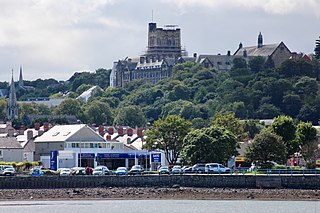
Bangor is a cathedral city and community in Gwynedd, North Wales. It is the oldest city in Wales. Historically part of Caernarfonshire, it had a population of 18,322 in 2019. Landmarks include Bangor Cathedral, Bangor University and Garth Pier. The Britannia and Menai Suspension bridges connect the city to the Isle of Anglesey.
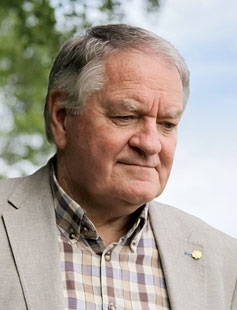
Dafydd Iwan Jones is a Welsh singer and nationalist politician who rose to fame writing and performing folk music in the Welsh language. From 2003 to 2010, Iwan was the president of Plaid Cymru, a political party which advocates for Welsh independence from the UK.
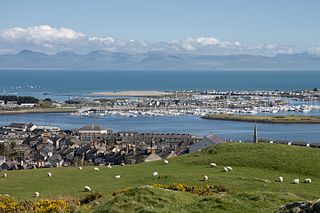
Pwllheli is a market town and community of the Llŷn Peninsula, north-western Wales. It lies in the traditional county of Caernarfonshire, but is currently administered as part of the unitary authority of Gwynedd. It had a population of 4,076 in 2011 of whom a large proportion, 81%, are Welsh speaking. Pwllheli is the place where Plaid Cymru was founded. It is the birthplace of the Welsh poet Sir Albert Evans-Jones.
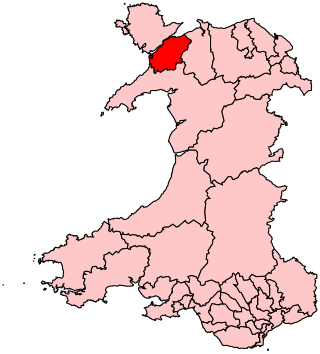
Arfon is a constituency in Wales represented in the House of Commons of the UK Parliament at Westminster. Although it is relatively large by geographical area, the constituency is a predominantly urban rather than rural seat, with the majority of the population living in the two towns of Bethesda and Caernarfon, as well as in the city of Bangor, on which the constituency is based. "Arfon" is a historical name for the area, meaning "facing Anglesey"; it is also the name of the former district council. This seat was created by the Welsh Boundary Commission in time for the 2010 general election; it replaced the old seat of Caernarfon. Bangor was in the old seat of Conwy. The same boundaries were used for the Arfon Welsh Assembly constituency in the 2007 Welsh Assembly election.
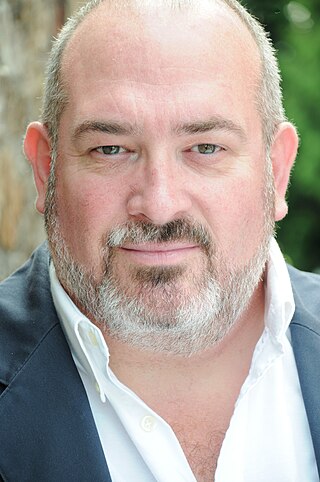
Ieuan Rhys is a Welsh actor. His television work has included thirteen years in the BBC Cymru soap opera Pobol y Cwm, Seargent Tom Swann in the last series of A Mind to Kill and six series of the Welsh-language version of Mr & Mrs – Sion a Sian for HTV. For the last four series he portrayed Eurig Bell, the "not to be messed with" Deputy Headmaster in S4C's Gwaith/Cartref.
William Samuel Jones, generally known as W. S. Jones or Wil Sam, was a Welsh-language author, playwright and scriptwriter.

Paul Griffiths is a Welsh writer, theatre critic and director. He won the Drama Medal at the National Urdd Gobaith Cymru Eisteddfod three times in succession between 1995 and 1997 – the only person ever to do this. Between March 2006 and December 2013 he contributed a controversial weekly theatre column to the National Paper of Wales Y Cymro. He is also a regular contributor on the Welsh language Television Channel S4C and BBC Radio Cymru.
Cwmni Theatr Ieuenctid Maldwyn are a music and theatre group based in mid Wales.

Angharad Tomos is a Welsh author and prominent language activist. She is a recipient of the Tir na n-Og Award.
National Theatre Wales (NTW) is a theatre company known for its large-scale site-specific productions and its grassroots work with diverse Welsh communities. It is the English-language national theatre of Wales, and refers to Theatr Genedlaethol Cymru, the Welsh-language national theatre of Wales founded in 2003, as its sister company.
Cofi is one of the regional accents and dialects of the Welsh language found in north Wales, and centred on Caernarfon, in Gwynedd, and its surrounding district. A person from Caernarfon is known colloquially as a Cofi.
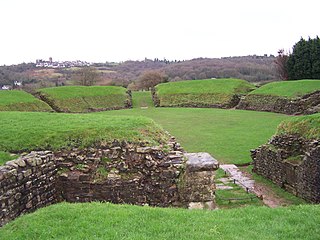
Theatre in Wales includes dramatic works in both the Welsh language and English language. Actors from Wales have also achieved international recognition.

Alice Gray Jones, OBE was a Welsh writer and editor, known by the pseudonym Ceridwen Peris. She was an active temperance campaigner, and a co-founder of the North Wales Women's Temperance Union.

Welsh Language Music Day is a music festival founded by radio presenter Huw Stephens. Events take place on the day at its base in Cardiff, as well as previously in London, Swansea, and even as far as Brooklyn and Budapest.

David Lyn Jenkins, known professionally as David Lyn, was a Welsh television, film and stage actor and director who in his 40 year career was at the forefront in the development of professional Welsh language theatre in Wales in the 1960s and 70s and won a BAFTA Cymru
John Gwilym Jones was a Welsh dramatist, novelist, short-story writer, drama director, academic and critic, considered a pre-eminent figure in those fields. In particular, he is widely acknowledged to be one of the two greatest 20th-century Welsh playwrights, along with Saunders Lewis; of his many plays, Hanes Rhyw Gymro (1964), Ac Eto Nid Myfi (1976) and Yr Adduned (1979) are considered masterpieces. Almost all of his work was written in the Welsh language. A writer in the modernist tradition, he is credited with introducing Brechtian techniques, stream-of-consciousness narrative and Freudianism to Welsh literature. Creative writers such as Kate Roberts and John Rowlands owed him a profound debt, and a whole generation of critics were influenced by his work as a teacher of Welsh literature.
Christine Pritchard was a Welsh actress. She was best known in Wales for her role as the witch in Rala Rwdins, a children's show on S4C in the 1990s. She featured in numerous Welsh language films and television series, such as Glas y Dorlan, Dinas, Pobol y Cwm, Cara Fi, and Anita. Her other roles included appearances on The Indian Doctor, Doctors and Stella. On stage she performed regularly with Theatr Genedlaethol Cymru. the Welsh-language national theatre of Wales.
References
- 1 2 3 Martin Morley: A Life in Theatre and TV Design, Morley Theatre Design website
- 1 2 'David Lyn: Actor who fought for Welsh theatre', The Independent , 17 October 2012
- ↑ Angharad Rees: Obituary from thestage.co.uk
- ↑ Cole, Deborah (8 Feb 1988). "Theatre's Last Curtain". Western Mail.
- ↑ Meic Stephens (April 1986). The Oxford companion to the literature of Wales . Oxford University Press. p. 153.
- 1 2 Cwmni Theatr Cymru Programmes and Posters, Archifdy Prifysgol Bangor / Bangor University Archives
- 1 2 Papurau Cwmni Theatr Cymru - Welsh Theatre Company Papers, Gwynedd Archives Service - Caernarfon Record Office / Gwasanaeth Archifau Gwynedd, Archifdy Caernarfon
- ↑ Cwmni Theatr Cymru, National Library of Wales Archive